Lark
Larks are passerine birds of the family Alaudidae. Larks have a cosmopolitan distribution with the largest number of species occurring in Africa. Only a single species, the horned lark, occurs in North America, and only Horsfield's bush lark occurs in Australia. Habitats vary widely, but many species live in dry regions. When the word "lark" is used without specification, it often refers to the Eurasian skylark (Alauda arvensis).[1]
| Lark | |
|---|---|
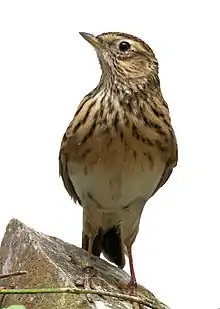 | |
| Eurasian skylark (Alauda arvensis) | |
| Scientific classification | |
| Kingdom: | Animalia |
| Phylum: | Chordata |
| Class: | Aves |
| Order: | Passeriformes |
| Superfamily: | Sylvioidea |
| Family: | Alaudidae Vigors, 1825 |
| Genera | |
|
see text | |
Taxonomy and systematics
The family Alaudidae was introduced in 1825 by the Irish zoologist Nicholas Aylward Vigors as a subfamily Alaudina of the finch family Fringillidae.[2][3] Larks are a well-defined family, partly because of the shape of their tarsus.[4] They have multiple scutes on the hind side of their tarsi, rather than the single plate found in most songbirds. They also lack a pessulus, the bony central structure in the syrinx of songbirds.[5] They were long placed at or near the beginning of the songbirds or oscines (now often called Passeri), just after the suboscines and before the swallows, for example in the American Ornithologists' Union's first check-list.[6] Some authorities, such as the British Ornithologists' Union[7] and the Handbook of the Birds of the World, adhere to that placement. However, many other classifications follow the Sibley-Ahlquist taxonomy in placing the larks in a large oscine subgroup Passerida (which excludes crows, shrikes and their allies, vireos, and many groups characteristic of Australia and southeastern Asia). For instance, the American Ornithologists' Union places larks just after the crows, shrikes, and vireos. At a finer level of detail, some now place the larks at the beginning of a superfamily Sylvioidea with the swallows, various "Old World warbler" and "babbler" groups, and others.[8][9] Molecular phylogenetic studies have shown that within the Sylvioidea the larks form a sister clade to the family Panuridae which contains a single species, the bearded reedling (Panurus biarmicus).[10] The phylogeny of larks (Alaudidae) was reviewed in 2013, leading to the recognition of the arrangement below.[11][12]
Extant genera
The family Alaudidae contains 100 extant species which are divided into 21 genera:[12] For more detail, see list of lark species.
| Image | Genus | Living Species |
|---|---|---|
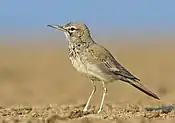 | Alaemon Keyserling & Blasius, 1840 |
|
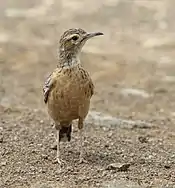 | Chersomanes Cabanis, 1851 |
|
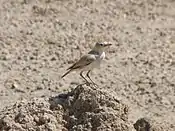 | Ammomanopsis Bianchi, 1905 |
|
_calling_..._(30544868485)%252C_crop.jpg.webp) | Certhilauda Swainson, 1827 |
|
_(6029254985).jpg.webp) | Pinarocorys Shelley, 1902 |
|
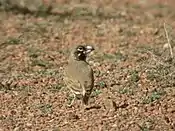 | Ramphocoris Bonaparte, 1850 |
|
_in_Kawal_WS%252C_AP_W_IMG_2004.jpg.webp) | Ammomanes Cabanis, 1851 |
|
.jpg.webp) | Eremopterix Kaup, 1836 |
|
.jpg.webp) | Calendulauda Blyth, 1855 |
|
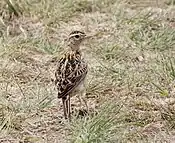 | Heteromirafra Grant, 1913 |
|
%252C_crop.jpg.webp) | Mirafra Horsfield, 1821 |
|
.jpg.webp) | Lullula Kaup, 1829 |
|
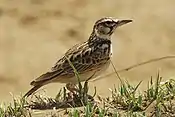 | Spizocorys Sundevall, 1872 |
|
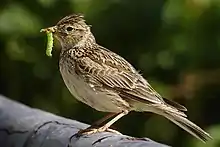 | Alauda Linnaeus, 1758 |
|
.jpg.webp) | Galerida Boie, F, 1828 |
|
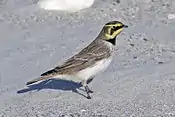 | Eremophila F. Boie, 1828 |
|
.jpg.webp) | Calandrella Kaup, 1829 |
|
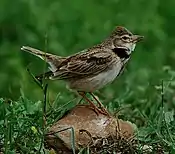 | Melanocorypha F. Boie, 1828 |
|
_(cropped).jpg.webp) | Chersophilus Sharpe, 1890 |
|
 | Eremalauda WL Sclater, 1926 |
|
_(8649673388)_(2)_(cropped).jpg.webp) | Alaudala Horsfield & Moore, 1858 |
|
Extinct genera
- Genus Eremarida — (Eremarida xerophila)
Description
_male.jpg.webp)
Larks, or the family Alaudidae, are small- to medium-sized birds, 12 to 24 cm (4.7 to 9.4 in) in length and 15 to 75 g (0.5 to 2.6 oz) in mass.[13] The smallest larks are likely the Spizocorys species, which can weigh only around 14 g (0.49 oz) in species like the pink-billed lark and the Obbia lark, while the largest lark is the Tibetan lark.[14]
Like many ground birds, most lark species have long hind claws, which are thought to provide stability while standing. Most have streaked brown plumage, some boldly marked with black or white. Their dull appearance camouflages them on the ground, especially when on the nest. They feed on insects and seeds; though adults of most species eat seeds primarily, all species feed their young insects for at least the first week after hatching. Many species dig with their bills to uncover food. Some larks have heavy bills (reaching an extreme in the thick-billed lark) for cracking seeds open, while others have long, down-curved bills, which are especially suitable for digging.[13]
Larks are the only passerines that lose all their feathers in their first moult (in all species whose first moult is known). This may result from the poor quality of the chicks' feathers, which in turn may result from the benefits to the parents of switching the young to a lower-quality diet (seeds), which requires less work from the parents.[13]
In many respects, including long tertial feathers, larks resemble other ground birds such as pipits. However, in larks the tarsus (the lowest leg bone, connected to the toes) has only one set of scales on the rear surface, which is rounded. Pipits and all other songbirds have two plates of scales on the rear surface, which meet at a protruding rear edge.[4]
Calls and song
Larks have more elaborate calls than most birds, and often extravagant songs given in display flight.[13] These melodious sounds (to human ears), combined with a willingness to expand into anthropogenic habitats — as long as these are not too intensively managed — have ensured larks a prominent place in literature and music, especially the Eurasian skylark in northern Europe and the crested lark and calandra lark in southern Europe.
Behaviour
Breeding
Male larks use song flights to defend their breeding territory and attract a mate. Most species build nests on the ground, usually cups of dead grass, but in some species the nests are more complicated and partly domed. A few desert species nest very low in bushes, perhaps so circulating air can cool the nest.[13] Larks' eggs are usually speckled. The size of the clutch is very variable and ranges from the single egg laid by Sclater's lark up to 6-8 eggs laid by the calandra lark and the black lark.[15] Larks incubate for 11 to 16 days.[13]
In culture
Larks as food
Larks, commonly consumed with bones intact, have historically been considered wholesome, delicate, and light game. They can be used in a number of dishes; for example, they can be stewed, broiled, or used as filling in a meat pie. Lark's tongues are reputed to have been particularly highly valued as a delicacy. In modern times, shrinking habitats made lark meat rare and hard to come by, though it can still be found in restaurants in Italy and elsewhere in southern Europe.[16]
Symbolism
The lark in mythology and literature stands for daybreak, as in Chaucer's "The Knight's Tale", "the bisy larke, messager of day",[17] and Shakespeare's Sonnet 29, "the lark at break of day arising / From sullen earth, sings hymns at heaven's gate" (11–12). The lark is also (often simultaneously) associated with "lovers and lovers' observance" (as in Bernart de Ventadorn's Can vei la lauzeta mover) and with "church services",[18] and often those the meanings of daybreak and religious reference are combined (in Blake's Visions of the Daughters of Albion, into a "spiritual daybreak"[19] to signify "passage from Earth to Heaven and from Heaven to Earth".[20] In Renaissance painters such as Domenico Ghirlandaio the lark symbolizes Christ, in reference to John 16:16.[21]
Literature
Percy Bysshe Shelley's famed 1820 poem To a Skylark was inspired by the melodious song of a skylark during an evening walk.[22]
Pet
Traditionally larks are kept as pets in China. In Beijing, larks are taught to mimic the voice of other songbirds and animals. It is an old-fashioned habit of the Beijingers to teach their larks 13 kinds of sounds in a strict order (called "the 13 songs of a lark", Chinese: 百灵十三套). The larks that can sing the full 13 sounds in the correct order are highly valued, while any disruption in the songs will decrease its value significantly.[23]
"On a lark" Phrase
In english, the term "on a lark" describes something that is done on the spur of the moment, something that is done spontaneously and for fun. The word lark in the term on a lark is used to mean frolicking or playing. The use of the word lark to mean frolicking first appeared in the early 1800s. It may stem from the word skylark, slang used by sailors to mean roughhousing in the rigging. It may date back to the Old Norse word leika which means to play. A third possibility is an Old English dialect word lake, which means to leap and play. [24]
See also
- Lark bunting
- Lark sparrow
- Magpie-lark (Neither a lark nor a magpie, but a giant monarch flycatcher)
- Meadowlark
- Titlark, a synonym for meadow pipit
- Songlark
- "Alouette" (a song)
References
- "lark". Oxford English Dictionary (Online ed.). Oxford University Press. (Subscription or participating institution membership required.)
- Bock, Walter J. (1994). History and Nomenclature of Avian Family-Group Names. Bulletin of the American Museum of Natural History. Vol. Number 222. New York: American Museum of Natural History. pp. 149, 264. hdl:2246/830.
- Vigors, Nicholas Aylward (1825). "On the arrangement of the genera of birds". Zoological Journal. 2: 391–405 [398].
- Ridgway, Robert (1907). "The Birds of North and Middle America, Part IV". Bulletin of the United States National Museum. 50: 289–290.
- Ames, Peter L. (1971). The morphology of the syrinx in passerine birds (PDF). Bulletin 37, Peabody Museum of Natural History. New Haven, Connecticut: Yale University. p. 104.
- Patterson, Bob (2002). "The History of North American Bird Names in the American Ornithologists' Union Checklists 1886 - 2000". Retrieved 24 June 2008.
- Dudley, Steve P.; Gee, Mike; Kehoe, Chris; Melling, Tim M. (2006). "The British List: A Checklist of Birds of Britain (7th edition)" (PDF). Ibis. 148 (3): 526–563. doi:10.1111/j.1474-919X.2006.00603.x.
- Barker, F. Keith; Barrowclough, George F.; Groth, Jeff G. (2002). "A phylogenetic hypothesis for passerine birds: taxonomic and biogeographic implications of an analysis of nuclear DNA sequence data". Proceedings of the Royal Society B. 269 (1488): 295–308. doi:10.1098/rspb.2001.1883. PMC 1690884. PMID 11839199.
- Alström, Per; Ericson, Per G.P.; Olsson, Urban; Sundberg, Per (2006). "Phylogeny and classification of the avian superfamily Sylvioidea". Molecular Phylogenetics and Evolution. 38 (2): 381–397. doi:10.1016/j.ympev.2005.05.015. PMID 16054402.
- Fregin, Silke; Haase, Martin; Olsson, Urban; Alström, Per (2012). "New insights into family relationships within the avian superfamily Sylvioidea (Passeriformes) based on seven molecular markers". BMC Evolutionary Biology. 12 (157): 1–12. doi:10.1186/1471-2148-12-157. PMC 3462691. PMID 22920688.
- Alström, Per; Barnes, Keith N.; Olsson, Urban; Barker, F. Keith; Bloomer, Paulette; Khan, Aleem Ahmed; Qureshi, Masood Ahmed; Guillaumet, Alban; Crochet, Pierre-Andre; Ryan, Peter G. (2013). "Multilocus phylogeny of the avian family Alaudidae (larks) reveals complex morphological evolution, non-monophyletic genera and hidden species diversity" (PDF). Molecular Phylogenetics and Evolution. 69 (3): 1043–1056. doi:10.1016/j.ympev.2013.06.005. PMID 23792153.
- Gill, Frank; Donsker, David; Rasmussen, Pamela, eds. (January 2022). "Nicators, Bearded Reedling, larks". IOC World Bird List Version 12.1. International Ornithologists' Union. Retrieved 18 July 2022.
- Kikkawa, Jiro (2003). "Larks". In Perrins, Christopher (ed.). Firefly Encyclopedia of Birds. Firefly Books. pp. 578–583. ISBN 1-55297-777-3.
- Dunning, John B. Jr., ed. (2008). CRC Handbook of Avian Body Masses (2nd ed.). CRC Press. ISBN 978-1-4200-6444-5.
- de Juana, Eduardo; Suárez, Francisco; Ryan, Peter (2004). "Family Alaudidae (Larks)". In del Hoyo, J.; Elliott, A.; Christie, D.A. (eds.). Handbook of the Birds of the World. Vol. 9: Cotingas to Pipits and Wagtails. Barcelona, Spain: Lynx Edicions. pp. 496–541. ISBN 978-84-87334-69-6.
- Hooper, John (2010-02-17). "Cat, dormouse and other Italian recipes". The Guardian. London. Retrieved 2010-05-07.
- Benson, Larry D. (2008). The Riverside Chaucer (3rd ed.). Oxford: Oxford University Press. p. 45, line 1491. ISBN 978-0-19-282109-6.
- Bawcutt, Priscilla (1972). "The lark in Chaucer and some later poets". Yearbook of English Studies. 2: 5–12. doi:10.2307/3506502. JSTOR 3506502.
- Baine, Rodney M.; Baine, Mary R. (1986). The scattered portions: William Blake's biological symbolism. p. 70. ISBN 978-0-935265-10-1.
- Stevens, Anthony (2001). Ariadne's Clue: A Guide to the Symbols of Humankind. Princeton University Press. p. 363. ISBN 978-0-691-08661-3.
- Cadogan, Jeanne K. (2000). Domenico Ghirlandaio: artist and artisan. Yale University Press. p. 215. ISBN 978-0-300-08720-8.
- Sandy, Mark. "To a Skylark". The Literary Encyclopedia. Retrieved 28 December 2020.
- Jin, Shoushen (2005). 金受申讲北京. Beijing: Beijing Press. ISBN 9787200057935.
- "On a lark". 2018-02-24. Retrieved 2022-03-10.
- T, C. (1847). Lessons derived from the animal world. p. 269.
- "Up with the lark". Collins Dictionary. Retrieved 29 September 2022.
Further reading
- Meinertzhagen, R. (1951). "Review of the Alaudidae". Journal of Zoology. 121 (1): 81–132. doi:10.1111/j.1096-3642.1951.tb00739.x.
External links
- Lark videos, photos and sounds - Internet Bird Collection